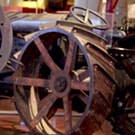
Agriculture and the Environment
Daily Activities at Agriculture: Innovations in Farming
This exhibit features tools and machinery that farmers used to grow crops, raise livestock, process eggs and dairy products, and generate power for farm use. Competing companies vied for the lucrative market. Farmers could select tractors best suited for row crops, orchards or market gardens. All machines, from husking pegs to microscopes, served a function -- traction engines for threshing crews, self-propelled combines for wheat farmers, and tomato harvesters for vegetable growers. The dynamic nature of farming helps make what is old, new again, as many find new uses for antique horse- or ox-drawn equipment, while others turn to no-till technology. Regardless, farmer choices can transform agriculture and the environment.
Highlights
Massey-Harris Model 20 Self-Propelled Combine, 1938
Artifact
Combine (Agricultural equipment)
Date Made
1938
Summary
"Combines" combine the major tasks of grain harvest: cutting and gathering the crop, threshing and separating the kernels from the chaff, and disposing of the straw. The Massey-Harris Model 20, introduced in 1938, culminated over 100 years of mechanical improvements. One driver operated the self-propelled machine, which reduced the need for hired help during the labor shortages of World War II.
Place of Creation
Keywords
Object ID
75.131.1
Credit
From the Collections of The Henry Ford. Gift of Henry L. Oldham.
Get more details in Digital Collections at:
Massey-Harris Model 20 Self-Propelled Combine, 1938
What is The Henry Ford?
The national attraction for discovering your ingenuity while exploring America’s spirit of innovation. There is always much to see and do at The Henry Ford.
Oliver Chilled Cast Iron Plow, circa 1895
Artifact
Plow (Agricultural equipment)
Date Made
circa 1895
Summary
The high-quality Oliver Chilled Plow dominated the market during the late 19th and early 20th centuries. Its creator, James Oliver, perfected "chilling," a casting process that created durable iron moldboards and shares that retained a smooth surface during heavy use. Farmers relied on dependable plows like the Oliver when preparing soil prior to planting crops.
Creators
Place of Creation
Object ID
00.1215.1
Credit
From the Collections of The Henry Ford. Gift of James Oliver, Sr.
Get more details in Digital Collections at:
Oliver Chilled Cast Iron Plow, circa 1895
What is The Henry Ford?
The national attraction for discovering your ingenuity while exploring America’s spirit of innovation. There is always much to see and do at The Henry Ford.
FMC Tomato Harvester, 1969
Artifact
Tomato harvester
Date Made
1969
Summary
Tomatoes need careful handling. Growers who contract with processors used to rely on human laborers. The quest to plant and harvest more, faster, gave mechanical engineers and plant geneticists incentive to design a machine and a tomato it could harvest. The FMC Cascade Harvester carried 10-12 laborers who sorted debris out of the crop, fewer laborers than growers had needed for handpicking.
Creators
Place of Creation
Object ID
91.142.1
Credit
From the Collections of The Henry Ford.
Related Objects
Get more details in Digital Collections at:
FMC Tomato Harvester, 1969
What is The Henry Ford?
The national attraction for discovering your ingenuity while exploring America’s spirit of innovation. There is always much to see and do at The Henry Ford.
Microscope Used by George Washington Carver, circa 1900
Artifact
Microscope
Date Made
circa 1900
Summary
By 1900, cotton production had depleted Southern soils, so George Washington Carver (1864-1943) developed nutritious crops like peanuts that nurtured the soil and could be sold to make industrial products. He used this microscope in his laboratory at the Tuskegee Institute in Alabama.
Creators
Object ID
97.6.1
Credit
From the Collections of The Henry Ford. Gift of Dr. Austin W. Curtis.
Get more details in Digital Collections at:
Microscope Used by George Washington Carver, circa 1900
What is The Henry Ford?
The national attraction for discovering your ingenuity while exploring America’s spirit of innovation. There is always much to see and do at The Henry Ford.
New Holland TR70 Axial Flow Combine, 1975
Artifact
Combine (Agricultural equipment)
Date Made
1975
Summary
Engineers designed the TR70 as a compact machine suitable for hilly terrain. The twin rotors (TR) shelled corn or threshed grain and moved it through the combine's body. Setting the rotors at an angle (axial) shortened the machine. Farmers changed the front-end attachment to harvest corn, beans, or wheat. Stencils on this prototype, exhibited at trade shows, explained additional features.
Object ID
87.123.1
Credit
From the Collections of The Henry Ford. Gift of Ford New Holland, Inc.
Get more details in Digital Collections at:
New Holland TR70 Axial Flow Combine, 1975
What is The Henry Ford?
The national attraction for discovering your ingenuity while exploring America’s spirit of innovation. There is always much to see and do at The Henry Ford.
Fordson Tractor, 1917-1918, Used by Luther Burbank
Artifact
Tractor (Agricultural equipment)
Date Made
1917-1918
Summary
The Fordson tractor, manufactured by Henry Ford and Son, Inc., was the first lightweight, mass-produced tractor that was affordable to the average farmer. Through this and other efforts, Henry Ford sought to relieve farmers of the burden of heavy labor. Ford gave this Fordson, the first production model, to fellow innovator Luther Burbank, creator of hundreds of new plant varieties.
Creators
Place of Creation
Object ID
00.136.291
Credit
From the Collections of The Henry Ford. Gift of Ford Motor Company.
Get more details in Digital Collections at:
Fordson Tractor, 1917-1918, Used by Luther Burbank
What is The Henry Ford?
The national attraction for discovering your ingenuity while exploring America’s spirit of innovation. There is always much to see and do at The Henry Ford.
Agriculture and the Environment
Come see first-hand some of the amazing agricultural inventions developed for farmers to use to produce and market foodstuffs. Explore engines, tractors and trucks, combines, and more in the Agriculture exhibit at the Henry Ford Museum of American Innovation.

Making Farming a Little Easier
Steam traction engines such as this one mechanized 19th-century farming.































